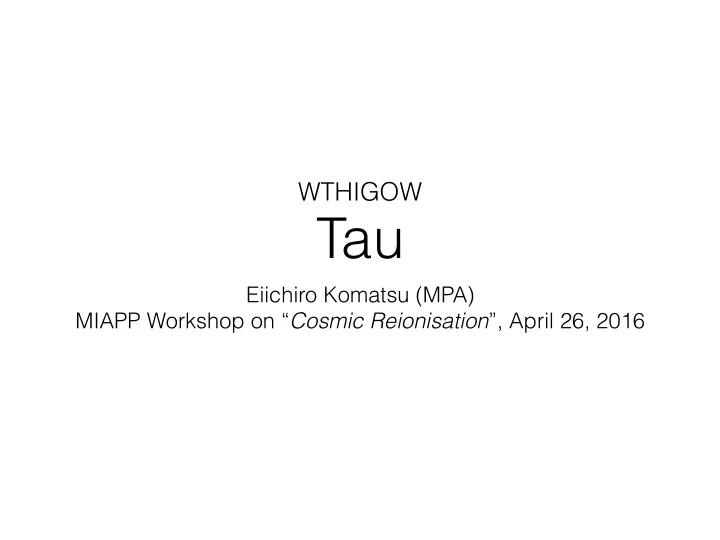

WTHIGOW Tau Eiichiro Komatsu (MPA) MIAPP Workshop on “ Cosmic Reionisation ”, April 26, 2016
What does tau do? • Tau suppresses power at high multipoles Temperature Power Spectrum [uK 2 ] High-ell power ~ A s exp(–2 τ ) ~ A s (1–2 τ ) τ =0.01 τ =0.066 Multipoles
What does tau do? • Tau adds polarisation power at low multipoles Polarisation Power Spectrum [uK 2 ] Low-ell polarisation power ~ A s τ 2 τ =0.066 τ =0.01 Multipoles
WMAP9 Paper; Planck 2015 Likelihood Paper Optical Depth [Temperature and Low-ell Polarisation Only; No CMB lensing information] Planck HFI T Planck HFI T Planck HFI T +WMAP9 P +LFI P +WMAP9+LFI P WMAP9 T+P cleaned by cleaned by cleaned by 353GHz 353GHz 353GHz τ 0.089±0.014 0.071±0.012 0.077±0.019 0.074±0.012 WMAP’s Polarisation and Planck LFI’s Polarisation are in very good agreement
WMAP9 Paper; Planck 2015 Likelihood Paper Optical Depth [Temperature and Low-ell Polarisation Only; No CMB lensing information] Planck HFI T Planck HFI T Planck HFI T +WMAP9 P +LFI P +WMAP9+LFI P WMAP9 T+P cleaned by cleaned by cleaned by 353GHz 353GHz 353GHz τ 0.089±0.014 0.071±0.012 0.077±0.019 0.074±0.012 10 9 A s e –2 τ 1.847 1.879 1.878 1.879 An increase in the best-fit A s e –2 τ (1.7%) can contribute to a downward shift τ [of order 0.017/2=0.0085]. Not just dust cleaning of the polarisation data
My Reaction [in both 2013 and 2014] • A drop from τ =0.089 to 0.074 (or so) • Fine . This is within the systematic error budget due to the foreground uncertainty quoted in the WMAP 5-year paper (Komatsu et al. 2009)
WMAP9 Paper; Planck 2015 Likelihood & Parameters Papers Optical Depth [Temperature and Low-ell Polarisation; plus CMB lensing information] Planck HFI T Planck HFI T Planck HFI T Planck HFI T +WMAP9 P +LFI P +WMAP9+LF +LFI cleaned WMAP9 T+P cleaned by cleaned by I P cleaned by 353GHz 353GHz 353GHz by 353GHz + Lensing τ 0.089±0.014 0.071±0.012 0.077±0.019 0.074±0.012 0.066±0.016 What happened?
WMAP9 Paper; Planck 2015 Likelihood & Parameters Papers Optical Depth [Temperature and Low-ell Polarisation, plus CMB lensing information] Planck HFI T Planck HFI T +LFI P cleaned by 353GHz +LFI P cleaned by 353GHz + CMB Lensing τ 0.077±0.019 0.066±0.016 Little change 10 9 A s e –2 τ 1.878±0.014 1.874±0.013 ~1 σ drop 10 9 A s 2.191 2.139±0.063 ~1 σ drop σ 8 0.829±0.014 0.815±0.009 A drop in tau comes from a drop in the amplitude preferred by lensing
Planck 2015 Parameters Paper
My Reaction • A drop from τ =0.074 to 0.066 • This could be a true value in our Universe, but it is not due to a change in the polarisation data, i.e., it is not a question about the unknown systematic errors in the polarisation data. It is more about the cosmological interpretation of the data as a whole (T+P+CMB lensing) • CMB lensing is still in its infancy, so let’s proceed with caution
Planck 2015 Parameters Paper A question for you: 0.078, 0.066, 0.067, 0.079, 0.063, 0.066 On what basis did you pick one (e.g., 0.066) among these numbers, without taking into account the spread in the interpretation?
Then I heard… • Jean-Loup Puget gave a talk, quoting a value from the analysis of Planck HFI data, cross-correlated with LFI: • τ =0.055±0.008(?) • I do not know any details of the analysis, so in principle I should not say anything about it, but let’s speculate for fun… • This value seems low, especially if nothing else in the analysis changed ; namely, if lensing etc were held fixed, it would be the polarisation data that pulled this • [But again, I do not know if everything else was held fixed] • If everything else was indeed held fixed, then I do not know how both WMAP and Planck LFI could be so off compared to the value of HFI. This is a question of the systematics!
WMAP vs Planck: Pros and Cons • WMAP : noisy, but a simple experiment in terms of the controls of systematics • Planck HFI : very sensitive, but a complicated experiment with the known systematics in large-angle polarisation Planck HFI can give you a very small statistical error. But what about systematic errors?
Planck 2013 HFI Data Processing Paper HFI’s known polarisation systematics are quite large on the reionisation bump, which needs to be subtracted. There is a way, but…
Planck 2013 HFI Data Processing Paper Polarisations are measured by differencing two detector pairs (a/b)
Aniello Mennella, at the “Planck 2014” Ferrara Conference LFI’s systematics are smaller than the reionisation bump
Take-home Messages • WMAP9 and Planck LFI polarisations are in agreement • No sign of the unknown systematic errors in these data sets • A drop from τ =0.089 [WMAP9 T+P] to 0.071 [Planck T+WMAP9 cleaned for dust] • A half of the drop from dust cleaning • Another half from an increase in the best-fit A s e –2 τ with the Planck 2015 temperature • A further drop to 0.066 is due to CMB lensing • So, ~2/3 of a drop from τ =0.089 to 0.066 is due to changes in non- polarisation data! • It would be a surprise if Planck HFI gave a much lower value: systematics may be at play
Recommend
More recommend